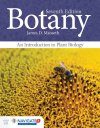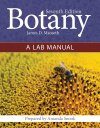Textbook
By: James D Mauseth(Author)
843 pages, colour & b/w photos, colour illustrations, colour tables
![Botany Botany]()
Click to have a closer look
About this book
Contents
Customer reviews
Biography
Related titles
Recommended titles
About this book
Botany: An Introduction to Plant Biology continues to set the standard for learning the fundamentals of plant science. In its seventh edition, Botany leads with the latest material on molecular biology, plant biotechnology, and the most recent coverage of taxonomy and phylogeny of plants to keep students at the forefront of cutting-edge botanical research.
Author Jim Mauseth carefully weaves the themes of ecology, evolution, and the impact of humans on other species and the environment into every chapter with the intention of teaching students about life in general. While the main details concern plant life, intertwined are lessons about general principles of biology, using human biology as relatable examples (e.g. Calcium: Strong bones, strong teeth but not strong plants). New Thinking about Thinking boxes teach students how to think critically and logically, so that after the course is over, students can continue to learn on their own.
Features:
- Thinking About Thinking. A new box type covering topics including evidence-based decision making, designing experiments, reductionist, and holistic thinking
- Updated Lab Manual. A new edition of our full-color, spiral-bound lab manual with additional case studies and image labeling activities
- Writing Style. Dr. Mauseth’s approachable writing style makes this text accessible to both majors and non-majors
- Plants & People. This text emphasizes how plants and people influence one another; how they are similar and how they are different
- Anatomy & Physiology. Dr. Mauseth’s narrative expertly connect structure to function in plants and supported with Botany in Action animations
Contents
Part 1 Introduction
Chapter 1 Introduction to Plants and Botany
Chapter 2 Overview of Plant Life
Chapter 3 Ethnobotany
Part 2 Plant Structure
Chapter 4 Cell Structure
Chapter 5 Growth and Division of the Cell
Chapter 6 Tissues and the Primary Growth of Stems
Chapter 7 Leaves
Chapter 8 Roots
Chapter 9 Structure of Woody Plants
Chapter 10 Flowers and Reproduction
Part 3 Plant Physiology and Development
Chapter 11 Energy Metabolism: Photosynthesis
Chapter 12 Energy Metabolism: Respiration
Chapter 13 Transport Processes
Chapter 14 Soils and Mineral Nutrition
Chapter 15 Development and Morphogenesis
Part 4 Genetics and Evolution
Chapter 16 Genes and the Genetic Basis of Metabolism and Development
Chapter 17 Genetics
Chapter 18 Population Genetics and Evolution
Chapter 19 Classification and Systematics
Chapter 20 Algae and the Origin of Eukaryotic Cells
Chapter 21 Nonvascular Plants: Mosses, Liverworts, and Hornworts
Chapter 22 Vascular Plants Without Seeds
Chapter 23 Seed Plants I: Gymnosperms
Chapter 24 Seed Plants II: Angiosperms
Part 5 Ecology
Chapter 25 Populations and Ecosystems
Chapter 26 Community Ecology
Chapter 27 Biomes
Customer Reviews
Biography
Research in James Mauseth's lab centers on evolution of morphogenic mechanisms and structure. They use cacti as model organisms because the family contains a great amount of structural/developmental diversity and because the cactus genus Pereskia retains numerous relictual characters. Plants of Pereskia have hard woody stems and ordinary large leaves. From ancestors like this, morphogenic mechanisms have evolved into ones capable of controlling the differentiation of various types of highly modified wood, unusual types of cortex that have leaf-like features, and apical meristems that minimize the number of mitoses necessary to produce large plants. Because each evolutionary line in the family has undergone particular types of modification of the morphogenic mechanism, they can compare different types of differentiation of a particular tissue, each type controlled by homologous morphogenic mechanisms.



































